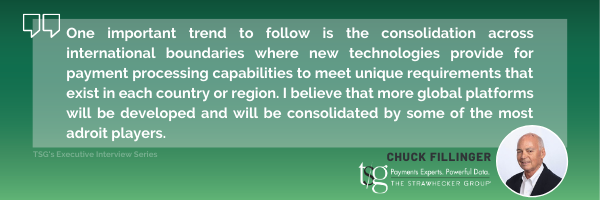
The Executive Interview Series provides readers with exclusive insights from movers and shakers in the payments industry. The Payments Industry is under continuous transformation, as such this series provides diverse perspectives on everything from strategy to payments technology and to the future of the industry.
In this interview, TSG’s Consulting team-member Zach Spellman sat down with TSG’s Senior Associate Chuck Fillinger to address areas of his expertise in payments and where he sees the industry heading.
Background: With over 30 years of experience in the payments industry, Chuck Fillinger has proven results working with merchant acquirers, gateways, and ISVs/VARs worldwide. Fillinger spent over twenty years at First Data where he was most recently responsible for Product Channel Development. Fun fact, Chuck is an inventor of five U.S. patents related to transacting at the POS.
TSG’s Zach Spellman:
Tell me more about your background. How did you get started in the payments industry?
A: Chuck Fillinger
My entire professional career has been directly involved within the payments industry. It all began in the retail credit space as a part-time employee while attending college in credit collections at Lazarus Department Store, Ohio. I progressed into various roles and as the Credit Authorization Manager, I developed and launched the first authorization-only point-of-sale (POS) terminal solution for our private label cards. I then accepted a transfer to another Federated Department stores division at Burdines of Florida.From my prior experience, I developed and enabled the authorization and capture of all card types that was integrated with NCR cash registers. This solution was a first for a department store and the transactions were routed to NaBanco, a third-party payments processor. I was then hired by NaBanco and managed a variety of areas; Client Relations, Chargeback electronic processing, responsible for the P&L of the Caribbean portfolio, developed partnerships with four of the major Canadian Banks, and implemented the first integrated POS hospitality solution for hotels and resorts in Mexico.
I then managed Product Development upon First Data acquiring NaBanco’s parent company, FFMC, and was instrumental in building out First Data’s international platform, OmniPay, to provide for multicurrency and Dynamic Currency Conversion processing. After a successful twenty-three years, I joined TSG in 2008 and have been enjoying working across the entire payments ecosystem.
TSG’s Zach Spellman:
Based on your experience in this industry, how has the evolution of payment acceptance changed as cloud-based technology becomes more widely available and adopted by merchants?
A: Chuck Fillinger
Based upon my lengthy and focused involvement pioneering electronic payment solutions, I have seen the evolution go from store clerks looking up card account numbers on warning bulletins and embossing card numbers on sales slips and submitting paper deposits to their bank to touchless mobile payments, I think that says it all. I am still somewhat surprised that some of the major payment processors continue to support their legacy back office systems that are expensive to update and maintain. Cloud-based payment systems require less capital expenditure to implement than physical systems and they are scalable to meet the changing needs that merchants will adopt over time. The cost of payment acceptance will remain top of mind for merchants of all sizes as they will continue to explore more viable and efficient solutions.
TSG’s Zach Spellman:
Tell me more about the introduction of Dynamic Currency Conversion (DCC) and your role in the development process of this solution.
A: Chuck Fillinger
At the time, DCC was prevalent throughout Europe and other regions and provided cardholders with a convenient and efficient method of making purchases internationally. While traveling in Europe for business, I was able to select the U.S. dollar for my transactions. When I returned to my office, I was able to reconcile and submit my expenses without having to wait for the next billing statement and the card schemes unknown currency conversion rates. Because of this, we knew it would be a successful solution for North America. Upon building out FDC’s international platform to integrate Multicurrency and DCC, I coordinated and managed a team within FDC’s IT, Product, Operations, Finance, Sales Channels, OmniPay and FEXCO to launch and enable selected merchants in specific markets and geographic areas that had high international travelers. This was a very successful program and continues to this day.
TSG’s Zach Spellman:
In your opinion, where do you see the payments industry heading in the next five to ten years, specifically around omnichannel services? How has the ongoing pandemic shaped the adoption of these services?
A: Chuck Fillinger
Unfortunately, the pandemic had a negative impact to merchants of all sizes and was most significant to travel and hospitality markets. Obviously, the pandemic has effected changes in all of our personal and professional lives, and has also expedited changes on how payments are accepted. Even though contactless payments have been around for several years, we are now experiencing an increase in NFC POS terminals being upgraded and deployed, and NFC enabled cards being distributed by card issuers. I just received this week a new NFC ATM debit card from my bank for the first time. Both cardholders and merchants are embracing this hands-free payment acceptance process. I have been an advocate of NFC for many years and am pleased to see its expanded use.The pandemic has also expedited merchants to reach consumers by enabling omnichannel services through developing online store fronts. They’ve also had to create promotions and offer delivery solutions to sell their inventories. I have observed the expansion of prepaid activity especially in the restaurant vertical where orders are placed and paid online and either the consumer or a delivery service will just walk in and pickup their prepared and packaged order. My wife and I were in a restaurant recently where only five tables were occupied, yet over twenty pickup orders were processed while we had our dinner. I believe this pattern will continue beyond the pandemic.
I also believe that more person-to-person and person-to-business payments will expand via the use of services like Zelle and Venmo as a convenient way of paying for goods and services. The next five to ten years will see more touchless and direct payment transactions through the expansion of NFC, omnichannel, and interbank direct payments.
TSG’s Zach Spellman:
Since joining TSG, tell me more about the type of project engagements you have been involved with and what typically gets you most excited to contribute?
A: Chuck Fillinger
I have really enjoyed working across the payments ecosystem through a variety of TSG engagements that I have been involved with. This is very refreshing to me as compared to my experience working within major organizations being more internally focused. I also enjoy building relationships with prospects and clients on providing solutions for them to support growing their business. The payments industry has always been exciting to me and continues to be ever-changing at a fast pace. Being associated with TSG’s leading position in the market allows for staying in front of the ongoing changes.
TSG’s Zach Spellman:
You play an active role in TSG’s Buy/Sell project engagements, can you briefly highlight why payment providers are targeting Independent Software Vendors (ISV) and the importance of integrating payments?
A: Chuck Fillinger
The concept of integrating specific vertical market software solutions has been around for several years and typically started out as referral relationships between ISV’s and payment providers. The integrations provided the ISV with another application in their software package and a new revenue stream. This also provided the payment providers with a new sales channel and improved merchant retention. The opportunity has now evolved through mergers and acquisitions whereby the payment processors have more control by having a direct relationship with merchants to provide a complete POS solutions package and further retention and overall profitability.
TSG’s Zach Spellman:
With your substantial background in international payment acceptance, what are some of the major trends or technological advances you have noticed throughout your experience in this industry?
A: Chuck Fillinger
Some of the technology trends that I have observed relate to comparing the North American payments space to other international countries and regions. Over time, the North American market has relied on its substantial infrastructure payment rails that did not exist in other global regions, and therefore those regions focused more so on developing mobile banking and payments technology. Mobile solutions have been more advanced in those regions vs North America because of this. During my travels throughout Europe, Central and South America, pay-at-the-table has been and is a very common practice whereby it still has not spread throughout North America. Pay-at-the-table is a technology that reduces fraud in one of the highest fraud vertical markets, beyond internet fraud. I have personally experienced fraudulent transactions in restaurants where employees have skimmed my card data and used it for their own purpose or sold the data to others.I have also observed how outsourcing payment processing has evolved from Financial Institutions (FI) outsourcing their entire portfolios that were heretofore very common in North America and in some global regions. I have now seen where this trend has somewhat changed with new scalable technologies, allowing FIs to bring back processing in-house or not outsource at all. During a TSG engagement in Brazil, a major FI determined that advancing new technology applications and operational efficiencies would allow them to maintain processing in-house compared to an outsource solution they were entertaining. One important trend to follow is the consolidation across international boundaries where new technologies provide for payment processing capabilities to meet unique requirements that exist in each country or region. I believe that more global platforms will be developed and will be consolidated by some of the most adroit players.

TSG’s Zach Spellman:
Tell me about some of your involvement with TSG’s Gateway Enterprise Metrics (GEM) platform and the importance of maintaining a quality-built payment gateway.
A: Chuck Fillinger
It all started when one of our major clients was looking to solve a significant issue they were having with one of their major clients. They first spent time researching the market for a viable solution and were unsuccessful. They then reached out to TSG knowing that we were independent and trusted based upon their knowledge of our proprietary data analytics platform, Acquiring Industry Metrics (AIM). They needed a solution that would benchmark their gateway’s real transaction processing performance against other gateways in the market.Coincidently, we had previously looked for performance monitoring technologies for other purposes and had not identified any beyond simple pinging of websites and nothing that would process and monitor real transactions. Since there was nothing in the market, we put our heads together to plan and develop a platform that processes authorization-only transactions all the way through to the card issuer and back to the gateway. GEM was then launched and began with only a handful of gateways but has since grown exponentially and has proven to be a valuable tool for our clients. Our initial client was able to resolve the issue with their client after receiving GEM reports overtime that indicated that their performance was acceptable to the client. Beyond the initial monitoring capabilities, GEM is now used by our clients to understand both the developer and merchant experiences in integrating and onboarding onto their gateways. GEM is a payments industry first and has been a very rewarding program.